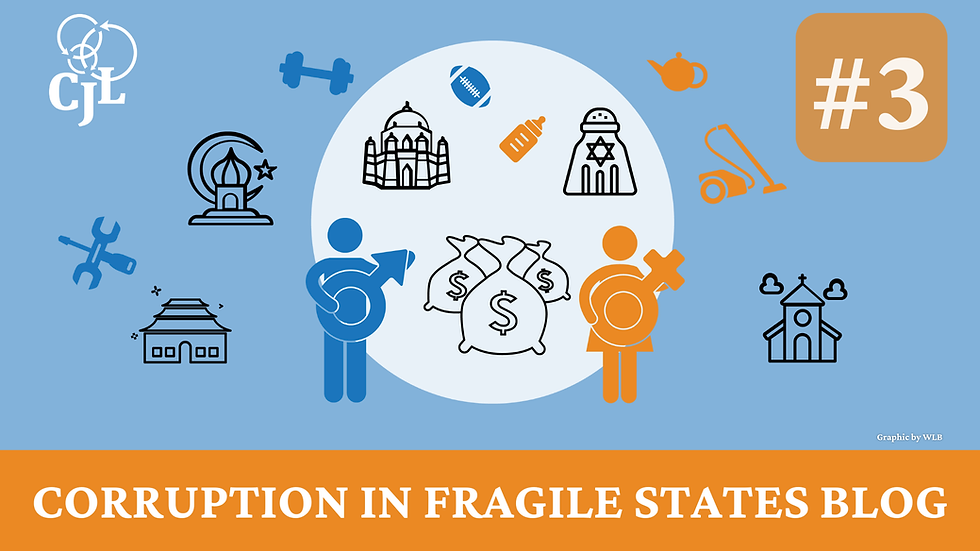Final Blog of the Corruption, Criminal Justice and Legitimacy Mini-Series
- Cheyanne-Scharbatke Church, CJL

- Jul 28, 2016
- 3 min read
By Cheyanne Scharbatke-Church

Do you need evidence to sway your donor that innovation is needed in anti-corruption programming because the old ways are insufficient? Are you trying to convince a colleague the necessity of looking at a wider array of issues in the context in order to understand what drives corruption? Do you dig systems-thinking? Are you interested in seeing it applied to more topics?
Then this paper, Taking the Blinders Off: Questioning how aid fights corruption is the right one for you. “Taking the Blinders Off” inspired our Corruption, Justice and Legitimacy blog mini-series, in which we distributed unique components of the paper to generate diverse conversations about corruption analysis, anti-corruption programming and practical recommendations for addressing gaps or weaknesses.
In our final post of the Corruption, Justice and Legitimacy blog mini-series, we summarize the core content of this paper, put out a call for guest posts and explain our anti-corruption blog’s summer hiatus.
Taking the blinders off
Explains why social norms, political culture and unintended effects must be taken into account in corruption assessments in fragile and conflict affected states.
Demonstrates how approaching corruption as a ‘simple’ problem undermines effectiveness and how both principal-agent and collective action approaches, which dominate anti-corruption programming, fall into the trap of simplicity by:
conflating factors that enable with factors that cause corruption
focusing on recipes rather than context
using the individual corrupt transaction as the focal point rather than the system
Makes plain how corruption in fragile and conflict affected states should be approached as a complex adaptive system and why that matters to anti-corruption programming.
Offers four recommendations on ways to improve corruption analysis and anti-corruption strategy development: conduct systems-focused analysis grounded in the context, adopt emergent design principles along with adaptive monitoring, pursue multi-faceted strategies and pursue strategic cooperation.
This is the first in a series of papers generated from the Corruption, Justice and Legitimacy program, based at the Henry J. Leir Institute. For those who would prefer a short video overview of this content, see:
We welcome your feedback on the paper and all comments on the blog.
Doing innovate thinking on corruption? Interested in a guest post?
The purpose of this anti-corruption blog series is to foster a space for conversation between actors working in the field of anti-corruption in fragile states. The goal is to explore systems-inspired strategies and tactics for changing corruption dynamics, and better means to analyse these dynamics in order to design innovative and effective programs.
As part of this we want to catalyze a community of practitioners, scholars and policy makers to share and discuss innovation, research and deep reflection on how to effectively combat corruption. Please reach out to Cheyanne Scharbatke-Church to discuss your post idea.
Summer Hiatus
The blog series on Corruption in Fragile States took a short summer break. It returned with renewed vim and vigor in September with guest author, esteemed corruption author and academic Michael Johnston, post “Breaking out of the Methodological Cage.” We encourage you to subscribe to the Corruption in Fragile States Blog to stay informed.
About the Author

Cheyanne Scharbatke-Church is Principal at Besa: Catalyzing Strategic Change, a social enterprise committed to catalysing significant change on strategic issues in places experiencing conflict and structural or overt physical violence. She has significant experience working on anti-corruption and state legitimacy in the DRC and Uganda. As a Professor of Practice, she teaches and consults on program design, monitoring, evaluation and learning.
Related Publication

Recognizing the limited set of tools for anti-corruption, this paper suggests that the limited effectiveness of programming in FCAS stems from a problem-strategy mismatch, wherein a simple response is being applied to a complex, systemic problem. Instead, we need a broader, more systemic analysis; strategic, emergent design and adaptive monitoring; and more multi-dimensional strategies.





Comments